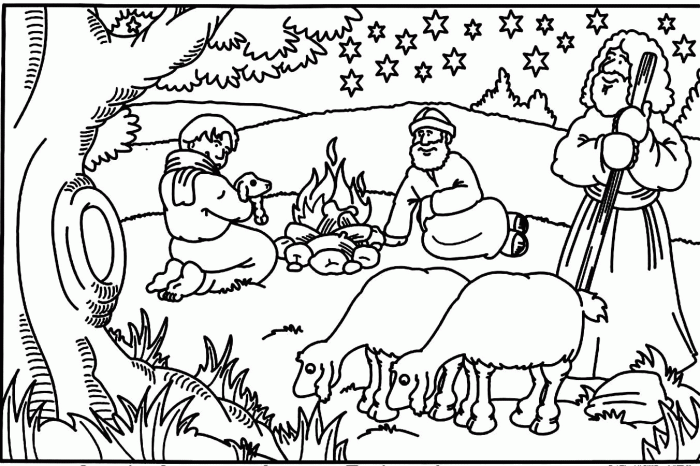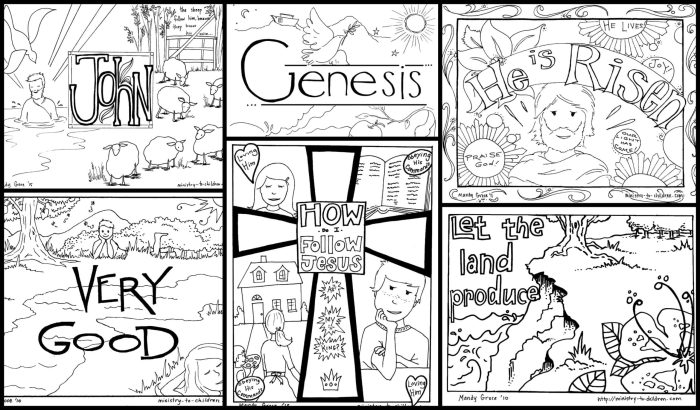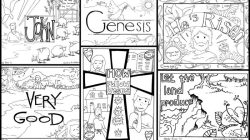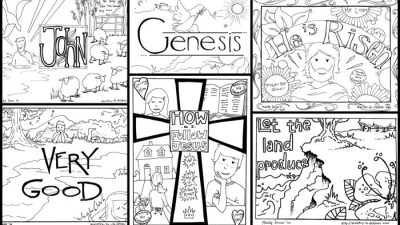Design and Artistic Aspects of Bible Book Coloring Pages

Creating engaging and visually appealing Bible book coloring pages requires careful consideration of various design and artistic elements. The line art style, layout, color palettes, and line weights all contribute to the overall effectiveness and appeal of the final product, impacting both the coloring experience and the message conveyed. The target age group significantly influences these choices.
Line Art Styles in Bible Book Coloring Pages
The style of line art significantly impacts the coloring experience and the overall aesthetic of the page. Different styles cater to various age groups and skill levels. The following table compares several common styles:
| Style | Complexity | Color Palette Suggestions | Target Age Group |
|---|---|---|---|
| Simple, bold Artikels | Low | Bright, primary colors; limited color choices | Young children (ages 3-5) |
| Detailed line art with intricate patterns | High | Varied, nuanced color palettes; allows for shading and blending | Older children (ages 8-12), teens, adults |
| Cartoonish style | Medium | Bright, cheerful colors; can incorporate gradients | Young children (ages 5-8) |
| Realistic style | High | Muted, natural tones; focus on accurate representation of textures and lighting | Teens, adults |
Coloring Page Layouts
The layout of a coloring page can significantly enhance the storytelling aspect. Three unique approaches are presented below:
Layout 1: Panel-style narrative: This layout divides the page into several panels, each depicting a scene from a Bible story. This allows for a visual narrative, guiding the colorist through the events. For example, the story of Noah’s Ark could be depicted in panels showing Noah building the ark, animals entering, the flood, and the ark landing. Each panel would have its own distinct scene, fostering a step-by-step understanding of the narrative.
Layout 2: Central figure with surrounding details: This layout features a central, larger figure (e.g., Jesus, Moses) surrounded by smaller, detailed scenes related to their story. This emphasizes the main character while providing context. For example, a coloring page featuring Jesus could have him in the center, surrounded by smaller images representing the miracles he performed. This design encourages focusing on the central figure while providing additional visual information.
Layout 3: Interactive scene: This layout encourages interaction by incorporating elements that require the colorist to complete the scene. For example, a coloring page depicting the Last Supper could have empty plates that the colorist can fill with colored food. This active participation adds another layer to the coloring experience, promoting engagement and creativity.
Color Palettes for Bible Scenes
Appropriate color palettes enhance the mood and atmosphere of the depicted scenes. Here are three examples:
Palette 1: Desert Scene (Exodus): This palette utilizes warm, earthy tones like sandy beige, burnt orange, deep ochre, and touches of dusty rose. These colors evoke the arid landscape of the desert, emphasizing the harsh conditions faced by the Israelites. The limited color range helps to create a feeling of dryness and vastness.
Palette 2: Peaceful Garden (Garden of Eden): This palette uses soft, muted greens, blues, and yellows. Pastel shades of mint green, sky blue, and lemon yellow create a serene and peaceful atmosphere, reflecting the tranquility of the Garden of Eden. The use of lighter shades emphasizes the calm and gentle nature of the scene.
Palette 3: Heavenly Scene (Heaven): This palette incorporates bright, luminous colors such as gold, pearl white, soft lavender, and sky blue. These colors create a sense of majesty and splendor, reflecting the beauty and glory of heaven. The use of shimmering gold and pearly white emphasizes a celestial and divine quality.
Line Weight and Texture, Bible book coloring pages
Varying line weights and textures adds depth and visual interest to coloring pages. Thicker lines can be used for outlining major figures or objects, creating emphasis. Thinner lines can be used for details and finer elements. Using textured lines (e.g., stippling, hatching) can add visual interest and create a sense of depth. For example, using thicker lines to Artikel the main characters in a scene and thinner lines for background details can create a clear focal point.
Similarly, using hatching to create shading on a character’s clothing can add a sense of realism and texture.
Educational and Developmental Value of Bible Book Coloring Pages

Bible book coloring pages offer a unique and engaging way to integrate faith-based learning with creative expression and cognitive development. They provide a multi-sensory approach to understanding biblical narratives and principles, making learning more accessible and enjoyable for children and adults alike. This method transcends passive learning, encouraging active participation and retention of information.Coloring pages can significantly aid in memorizing Bible verses or stories by connecting visual imagery with textual content.
The act of coloring a scene depicting a specific Bible story, for instance, reinforces the memory of the narrative through visual association. Similarly, incorporating key verses into the design itself, or having children write or trace the verse alongside their coloring, creates a strong visual and kinesthetic link to the scripture. This multi-sensory approach to learning improves retention significantly compared to simply reading or listening.
Utilizing Coloring Pages in Religious Education
Coloring pages are a versatile tool readily adaptable to various religious education settings. In Sunday school classes, they can be used as a quiet activity during transitions, a reward for good behavior, or an engaging component of a lesson. Teachers can use coloring pages as a springboard for discussions, prompting questions about the depicted scene or characters. For example, a coloring page illustrating the parable of the Good Samaritan could lead to a discussion about compassion and helping others.
In homeschool environments, coloring pages can be incorporated into weekly Bible studies, providing a hands-on activity that complements the lesson. Furthermore, coloring pages can serve as a personalized devotional tool for individual study and reflection. A child could color a page depicting a favorite Bible story and then journal their thoughts and feelings about it.
Stress Reduction and Mindfulness through Coloring
The act of coloring has been shown to have a calming effect, reducing stress and promoting mindfulness. This benefit is amplified within a religious context. Engaging with a Bible-themed coloring page allows individuals to focus on a specific image and the associated biblical narrative, creating a meditative space for reflection and prayer. The repetitive nature of coloring can be soothing, allowing individuals to quiet their minds and connect with their faith.
For example, coloring a page depicting a peaceful scene from nature, such as a landscape from the Psalms, can promote relaxation and a sense of connection with God’s creation. This practice can be particularly beneficial for individuals experiencing anxiety or stress, offering a tangible method for spiritual grounding.
Enhancing Learning and Engagement with Combined Activities
To maximize the educational and developmental benefits of Bible book coloring pages, several activities can be incorporated to enhance learning and engagement.
A range of supplemental activities can significantly enrich the experience of using Bible book coloring pages. These activities transform the coloring process from a simple task into a comprehensive learning experience.
- Storytelling: After coloring, children can retell the Bible story depicted in their coloring page, enhancing their comprehension and verbal skills.
- Verse Memorization: Incorporate key verses from the story into the coloring page design, encouraging memorization through repeated exposure.
- Creative Writing: Children can write a short story or poem inspired by the coloring page, fostering creative expression and deeper engagement with the narrative.
- Discussion and Reflection: Facilitate discussions about the moral lessons or spiritual themes presented in the Bible story, prompting critical thinking and spiritual growth.
- Arts and Crafts: Extend the activity by creating related crafts, such as making a diorama based on the coloring page scene, or constructing characters from the story using playdough or other materials.
Bible book coloring pages offer a relaxing and spiritual activity, perfect for all ages. For those seeking simpler designs to begin with, exploring resources like books coloring easy pages can be beneficial before tackling more intricate biblical scenes. Returning to the richly detailed world of Bible book coloring pages, one can find a wealth of imagery to reflect upon and color.










